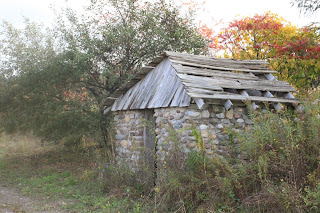The first building that you come to along the driveway is a stone springhouse standing next to a heritage apple tree. When we first saw the farm, the rustic charm of this stone building helped us fall in love with the entire property. The roof, at the time was nearly disintegrated, however, and the structure was without a door. A few more New York winters and this was sure to become a pile of fence stone. But given that this was the smallest of the buildings and that everything but the roof seemed salvageable, we designated this as our first undertaking.

Other buildings on the property had grown my love for timber framing. Something about the mass and conceptual integrity of framing with timbers using ancient joinery skills really appeals to me. Of course, I am not a skilled craftsman and I know few people who would put down their air nailer in favor of a handsaw and chisels. So I did what most "would be" apprentices of heritage skills do today - I bought some books and watched a load of youtube videos.
The most useful and easily understood information came from Timber Frame Construction , written by Jack Sobon and Roger Schroeder. In it, the authors give detailed instructions for building and assembling a 12x16 garden shed. I modified the dimensions and assembled the sills as plates directly on the stone building. I utilized the step-lapped rafter seat on the plates and open mortise and tenon joints on the rafter peaks (both described in detail in the book).
All of the joinery was cut in my garage over the course of the winter months using a combination of hand tools and power tools. As I worked, my love for hand tools grew. As I learn more about keeping keen edges on my tools, I will certainly use them more often and enjoy the serenity that comes from working with them.
Currently, the springhouse is serving as a storage place for hog feed. When it's cleaned out, I'll add some pictures of the inside including the joinery. Next year we hope to have it in operation as a springhouse once again. But oh the list of "next year" projects is forever growing. We'll have to wait and see. For now, I am thankful to have been able to save the stone structure and to have learned something in the process.


